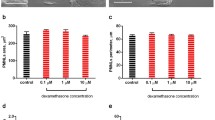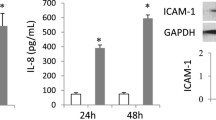Abstract
Adhesive interactions between macrophages and epithelial cells in the pulmonary alveoli may be important in the pathogenesis of inflammatory lung diseases, such as those induced by cigarette smoking. Potential mechanisms controlling the interactions between these cells were investigated using human alveolar macrophages (AM) and MDCK or A549 epithelial cells. Five percent human serum enhanced the adhesion of AM to MDCK cells by approximately 6-fold and to A549 cells by approximately 1.7-fold. This enhancement was reduced by heating the serum for 30 min at 55°C. Treating normal human serum with methylamine to inactivate C3, substituting C3-deficient serum, or pretreating serum-exposed MDCK cells with anti-C3 F(ab′)2 all significantly diminished the adhesion of AM, suggesting that complement is involved. With the use of flow cytometry to examine complement receptors on AM, both CD11b/CD18 and CD11c/CD18 were detected but CR1 was not evident. Preincubating AM with a monoclonal antibody to CD18 reduced the adhesion of AM to MDCK cells by 40% while a significant reduction could not be demonstrated after preincubation with antibodies to either CD11b or CD11c. These data suggest that in the presence of serum C3bi is deposited on the surface of MDCK cells and that AM may attach to these cells, at least in part, through interactions between C3bi and one or more receptors in the CD11/CD18 family, which are present on AM.
Similar content being viewed by others
References
Arnauot AM, Lanier LL, Faller DV (1988) Relative contribution of the leukocyte molecules Mol, LFA-1, and p150,95 (LeuM5) in adhesion of granulocytes and monocytes to vascular endothelium is tissue- and stimulus-specific. J Cell Physiol 137:305–309
Ault KA, Springer TA (1981) Cross-reaction of a rat-anti-mouse phagocyte-specific monoclonal antibody (anti-Mac-1) with human monocytes and natural killer cells. J Immunol 126:359–364
Beatty PG, Ledbetter JA, Martin PJ, Price TH, Hansen JA (1983) Definition of a common leukocyte cell surface antigen (Lp95-150) associated with diverse cell-mediated immune functions. J Immunol 131:2913–2918
Bullock WE, Wright SD (1987) Role of the adherence-promoting receptors, CR3, LFA-1, and p150,95, in binding ofHistoplasma capsulatum by human macrophages. J Exp Med 165:195–210
Cerejido M, Robbins ES, Dolan WJ, Rotunno CA, Sabatini DO (1978) Polarized monolayers formed by epithelial cells on a permeable and translucent support. J Cell Biol 77:853–880
Cole FS, Matthews WJ, Rossing TH, Gosh DJ, Lictenberg NA, Pennington JE (1983) Complement synthesis by human bronchoalveolar macrophages. Clin Immunol Immunopathol 27:153–159
Cramer EB, Milks LC, Brontoli MJ, Ojakian GK, Wright SD, Showell HJ (1986) Effect of human serum and some of its components on neutrophil adherence and migration across an epithelium. J Cell Biol 102:1868–1877
Fels A, Cohn ZA (1986) The alveolar macrophage. J Appl Physiol 60:353–369
Heitzmann H, Richards FM (1974) Use of the avidin-biotin complex for specific staining of biological membranes in electron microscopy. Proc Nat Acad Sci 71:3537–3541
Hunninghake GW, Gadek JE, Kawanami D, Ferrans VJ, Crystal RG (1979) Inflammatory and immune processes in the human lung in health and disease: evaluation by bronchoalveolar lavage. Am J Pathol 97:149–198
Idell S, Gonzalez K, Bradford H, MacArthur CK, Fein AM, Maunder RJ, Garcia JG, Griffith DE, Weiland J, Martin TR, McCarty J, Fair DS, Walsh PN, Colman RW (1987) Procoagulant activity in bronchoalveolar lavage in the adult respiratory distress syndrome. Am Rev Respir Dis 136:1466–1474
Keizer GD, Te Velde AA, Schwarting R, Fidgor CG, deVries JE (1987) Role of p150,95 in adhesion migration, chemotaxis and phagocytosis by human monocytes. Eur J Immunol 17:1317–1322
Kew RR, Ghebrehiwet B, Janoff A (1985) Cigarette smoke can activate the alternative pathway of complement in vitro by modifying the third component of complement. J Clin Invest 75:1000–1007
Kew RR, Ghebrehiwet B, Janoff A (1986) The role of complement in cigarette smoke-induced chemotactic activity of lung fluids. Am Rev Respir Dis 133:478–481
Lamule B, Griffin JH (1985) Formation of the fibrin clot: the balance of procoagulant and inhibitory factors. Clin Haematol 14:281–342
Lanier L, Arnaout MA, Schwarting R, Warner NL, Ross GD (1985) p150,95, Third member of the LFA-1/CR3 polypeptide family identified by anti-LeuM5 monoclonal antibody. Eur J Immunol 15:713–718
Malhotra V, Hogg N, Sim RB (1986) Ligand binding by the p150,95 antigen of U937 monocytic cells: properties in common with complement receptor type 3 (CR3). Eur J Immunol 16:1117–1123
Mason GR, Uszler JM, Effros RM, Reid E (1983) Rapidly reversible alterations of pulmonary epithelial permeability induced by smoking. Chest 83:6–11
McGee MP, Rothberger H (1985) Tissue factor in bronchoalveolar lavage fluids. Evidence for an alveolar macrophage source. Am Rev Respir Dis 131:331–336
McGowan SE, Stone PJ, Calore JD, Snider GL, Franzblau C (1983) The fate of neutrophil elastase incorporated by human alveolar macrophages. Am Rev Respir Dis 127:449–455
Miller LJ, Bainton DF, Borregaard N, Springer TA (1987) Stimulated mobilization of monocyte Mac-1 and p150,95 adhesion proteins from an intracellular vesicular compartment to the cell surface. J Clin Invest 80:535–544
Minty BD, Royston D (1985) Cigarette smoke induced changes in rat pulmonary clearance of99mTcDTPA. A comparison of particulate and gas phases. Am Rev Respir Dis 132:1170–1173
Myones BL, Daizell JG, Hogg N, Ross GD (1988) Neutrophil and monocyte cell surface p150,95 has iC3b-receptor (CR4) activity resembling CR3. J Clin Invest 82:640–651
Pangburn MK (1988) Alternative pathway of complement. In: Colowick SP, Kaplan NO (eds) Methods in enzymology, vol. 62. Academic Press, New York, pp 639–653
Simon RH, DeHart PD, Todd RF (1986) Neutrophil-induced injury of rat pulmonary alveolar epithelial cells. J Clin Invest 78:1375–1386
Takada A, Shirahama S, Takada Y (1985) Conformational changes of complement components C3 and B-induced at higher temperature. Complement 2:193–203
Te Velde AA, GD Keizer, Figdor CG (1987) Differential function of LFA-1 family molecules (CD11 and CD18) in adhesion of human monocytes to melanoma and endothelial cells. Immunology 61:261–267
Weibel ER (1963) Morphometry of the human lung. Academic, Press, New York
Wright SD, Detmers PA (1988) Adhesion-promoting receptors on phagocytes. J Cell Sci Suppl 9:99–120
Author information
Authors and Affiliations
Rights and permissions
About this article
Cite this article
McGowan, S.E., Heckman, J.G. Mechanisms of serum-enhanced adhesion of human alveolar macrophages to epithelial cells. Lung 169, 215–226 (1991). https://doi.org/10.1007/BF02714156
Accepted:
Issue Date:
DOI: https://doi.org/10.1007/BF02714156




